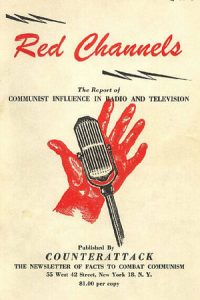
The Cold War & Internal Security Collection and Joyner Library Special Collections are hosting a joint exhibit titled “HUAC Goes to Hollywood: Aspects of the Blacklist 70 Years Later.” The exhibit can be found on the first floor of Joyner Library, and will remain up through the end of December. This is the second of four CWIS blog posts that will expand on this exhibit.
While the initial Hollywood blacklist, inaugurated in the wake of the 1947 Hollywood Ten hearings, was prompted by the efforts of the House Un-American Activities Committee (HUAC), it was largely sustained by private businesses and pressure groups. Using information published by HUAC and other governmental investigative bodies, along with the results of their own research, a private-sector network of freelance “Red-hunters” emerged by the end of the 1940s. Working individually, in small consulting firms, or as part of larger pressure/advocacy organizations, these Red-hunters would produce evidence that many entertainment industry professionals were tied to the communist party (CPUSA). The persons they named would then either have to go through an elaborate clearance process, or find themselves blacklisted.
It would be one such small consulting business, founded by three former FBI agents, that in 1950 produced a volume that scholars call “the bible of the blacklist.”
ABC and the Origins of Red Channels:
In 1944, HUAC published its voluminous files on organizations believed tied to the CPUSA in a three volume compilation called Appendix IX. This set included the text of numerous committee lists, petitions, endorsements, and other documentation of political activities. In all, Appendix IX contained the names of over 22,000 individuals, many of whom had little or no real connection to the CPUSA. Appendix IX was published out of fear that HUAC would not be renewed by the next congress, and thus this material would be lost. After HUAC was made a permanent body in early 1945, the committee realized the danger caused by publishing such a large amount of raw information containing so many individual names, and withdrew the document from publication. Some copies would survive, however, and become a major source of names for the blacklist.
In the spring of 1947, three former FBI agents, Kenneth Brierly, Theodore Kirkpatrick, and John Keenan, formed American Business Consultants (ABC), a small firm that researched, and published information on, communist activity in American society. Their periodical, Counterattack, eventually became a major source of names for studio blacklisters. In 1950, ABC hired a former naval intelligence officer named Vincent Hartnett to help with their research. On June 22, 1950, ABC published the fruits of Hartnett’s research, a volume entitled Red Channels: The Report of Communist Influence in Radio and Television
Drawing heavily on Appendix IX and other HUAC publications, Red Channels alleged that 151 professional entertainers were involved in communist activity. Those listed in Red Channels soon found themselves added to the blacklist, and found it virtually impossible to obtain work in radio or television. Red Channels became an indispensable source for blacklisters. Relying on information from it and other sources, groups such as the American Legion enforced the blacklist through boycotts and picketing. To have themselves removed, blacklistees had to undergo a lengthy “clearance” process, which involved renouncing communism and testifying before HUAC or a similar congressional body. The freelance “Red-hunters” at ABC and elsewhere offered their services to guide repentant blacklistees through this process, often for a fee.
With the publication of Red Channels, Hartnett found himself considered an expert on the topic of alleged communist infiltration of the entertainment industry. He would make several appearances before HUAC and related congressional committees. The blacklist his work helped fuel would reach its height by the mid-1950s.
CWIS/Hoover Collection Sources:
American Business Consultants, Inc. Red Channels: The Report of Communist Influence in Radio and Television. New York: Counterattack, 1950. (Joyner Hoover Collection: HE8698.6.A63X 1950)
American Business Consultants, Inc. Counterattack, 13 (1959). (Joyner Hoover Collection: E838 .C6 V. 13)
Investigation of Un-American Propaganda Activities in the United States. [Hearings] Seventy-Eighth Congress, Second Session on H. Res. 282. Appendix, Part IX: Communist Front Organizations, With Special Reference to the National Citizens Political Action Committee. 1944, 3 v. (Joyner Docs CWIS: Y 4.UN 1/2:UN 1/944/APP./; also available in Joyner Hoover E743.5 .A412)
Subversive Infiltration of Radio, Television and the Entertainment industry: Hearings Before the Subcommittee to Investigate the Administration of the Internal Security Act and Other Internal Security Laws of the Committee on the Judiciary, United States Senate, Eighty-Second Congress, First and Second sessions. 1952, 2 pts. (Joyner Docs CWIS: Y 4.J 89/2:SU 1/7)
-Features testimony by Hartnett.
Other Sources:
Cogley, John. Report on Blacklisting: II – Radio – Television. New York: Fund for the Republic, 1956. (Joyner Stacks: PN1993.5.U6 C6 V. 2)
Hill, Jason. Red Channels: The Bible of Blacklisting. Albany, GA: BearManor Media, 2016. (Joyner Stacks: PN1993.5.U6 H5 2016)
McDonough, John. “Reliving The Scare: Looking Back On ‘Red Channels’.” NPR, June 22, 2010.
Powers, Richard Gid. Not Without Honor: The History of American Anticommunism. New York: Free Press, 1995. (Joyner Stacks: E743.5 .P65 1995)
Schrecker, Ellen. The Age of McCarthyism: A Brief History with Documents. 2nd ed. Boston: Bedford/St. Martin’s, 2002. (Joyner Stacks: E743 .S377 2002)